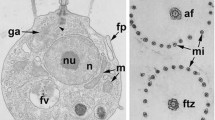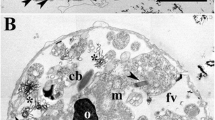Summary
The ultrastructural investigation of Noctiluca miliaris reveals in the tentacle of the vegetative individual the existence of narrow fibrillar bands transversely striated: they are radially inserted at the level of a layer of longitudinal peripheral microtubules. The main striation S has a period of 0,2 μ and the secondary stria s a period of 0,1 μ. These periods may slightly vary. The study of the folding and of the tentacular motions reveals the important role played by the striated narrow bands and the peripheral microtubules.
The observation of the buccal complex shows a cytostome and a buccal cone with a complex wall, provided with fibrous and mucous trichocysts. At the internal level of the wall is inserted a screen of long bundles of striated fibres, linked to the posterior furrow. The period of these fibres varies from 0,1 to 0,3 μ. They are certainly contractile.
In the sporocytes, these formations do not exist. The flagellar apparatus is composed of a single flagella of classical structure, but its whip is provided with a helical cord.
The study of these different elements allows one to make comparisons between Noctiluca, other Dinoflagellates and other Protozoans affirming the uniqueness of the Noctilucinae.
Résumé
L'étude ultrastructurale de Noctiluca miliaris révèle dans le tentacule du Trophozoïte l'existence de bandelettes fibrillaires striées transversalement; elles sont insérées radialement au niveau d'une couche de microtubules périphériques longitudinaux. La striation principale S a une période de 0,2 μ et les stries secondaires s une période de 0,1 μ; ces périodes peuvent varier légèrement. L'étude du plissement et des mouvements tentaculaires révèle le rôle important joué par les bandelettes striées et les microtubules périphériques.
L'observation du complexe buccal met en évidence un cystotome et un cône buccal à paroi complexe, armé de trichocystes fibreux et muqueux. Au niveau interne de la paroi, est inséré un rideau de longs faisceaux de fibres striées, relié au sillon postérieur. La période de striation transversale de ces fibres varie de 0,1 à 0,3 μ. Leur contractilité ne fait aucun doute.
Dans les sporocytes, ces diverses formations n'existent pas; l'appareil flagellaire est composé d'un flagelle unique de structure classique, mais dont le fouet est garni d'un cordon spiralé.
L'étude de ces divers éléments a permis d'effectuer des comparaisons entre Noctiluca, d'autres Dinoflagellés et d'autres Protistes, affirmant ainsi l'originalité des Noctilucinae.
Similar content being viewed by others
Bibliographie
Afzelius, B. A.: The nucleus of Noctiluca scintillans. Aspects of nucleocytoplasmic exchanges and the formation of nuclear memhrane. J. Cell. Biol. 19 (1), 229–238 (1963).
Halyarson, M.: The fine structure of the photogenic granules in Dinoflagellates. Third European Conf. on Electr. microsc., p. 175–176. Prague: Publish. House of the Czekoslovak Acad. Sci. 1964.
Anderson, E., Beams, H. W.: The ultrastructure of Tritrichomonas with special reference to the blepharoblast complex. J. Protozool. 8, 71–75 (1961).
Batisse, A.: Les ultrastructures squelettiques chez certains Thecacinetidae. Protistologica 4 (4), 477–492 (1968).
Bovier-Lapierre, E.: Observations sur les Noetiluques. C.R. Soc. Biol. (Paris) 40, 579 (1886).
Butschli, O.: Einige Bemerkungen über die gewissen Organisationsverhältnisse der sog. Cilioflagettaten und der Noctiluca. Morph. Jb. 10, 529–577 (1885).
Cachon, J.: Contribution à l'étude des Péridiniens parasites. Cytologie. Cycles évolutifs. Anns. Sci. nat. 6, 1–158 (1964).
—, Cachon, M.: Cymbodinium elegans nov. gen. nov. sp., Péridinien Noctilucidae Saville-Kent. Protistologica 3 (3), 313–318 (1967).
—: Contribution à l'étude des Noctilucidae Saville-Kent. I. Les Kofoidininae Cachon, J. et M. Evolution morphologique et systématique. Protistologica 3 (4), 427–444 (1967).
—: Pomatodinium impatiens, nov. gen. nov. sp., Péridinien Noctilucidae Kent. Protistologica 2 (1), 23–30 (1966).
—, et Cachon, M., Pyne, Ch.: Structure et ultrastructure de Paradinium poucheti Chatton 1910, et position systématique des Paradinides. Protistologica 4 (3), 303–311 (1968).
Calkins, G. N.: Mitosis on Noctiluca miliaris and its bearing on the nuclear relations of the Protozoa and Metazoa. J. Morph. 15, 711–722 (1899).
Carasso, N., Favard, P.: Mise en évidence du Calcium dans les myonèmes pédonculaires de Ciliés Péritriches. J. Microsc. 5, 759–770 (1966).
Davies, R. E.: A molecular theory of muscle contraction: Calcium dependent contractions with hydrogen bond formation plus ATP-dependent extensions of part of the myosinactin cross-bridges. Nature (Lond.) 199, 1068–1074 (1963).
Dingle, A. D., Fulton, C.: Development of the flagellar apparatus of Naegleria. J. Cell Biol. 31, 43–54 (1966).
Dodge, J. D., Crawford, R. M.: Fine Structure of the Dinoflagellate Amphidinium carteri. Protistologica 4 (2), 231–242 (1968).
Eckert, R.: Bioluminescence and electrical activity in a single cell, Noctiluca miliaris, luminescent marine dinoflagellate. 16th Int. Congr. of Zool. Proc. Int. Congr. Zool. 16 (2), 74 (1963).
—: Bioelectric control of bioluminescence in the dinoflagellate Noctiluca. Science 147, 1410–1415 (1965).
—: Subcellular Sources of luminescence in Noctiluca. Science 151, 349–352 (1966).
Fauré-Fremiet, E.: Le tentacule de la Noctiluca miliaris. Bull. Soc. Biol. France 35, 8 (1910).
—, Favard, P., Carasso, N.: Etude au microscope électronique des ultrastructures d'Epistylis anastatica (Cilié Péritriche). J. Microsc. 1, 287–312 (1962).
—, Rouiller, C.: Réseaux canaliculaires dans les myonèmes endoplasmiques de quelques Ciliés. C. r. hebd. Séanc. Acad. Sci. (Paris) 246, 2039–2042 (1958).
Gabe, M.: Techniques histologiques. Paris: Masson & Cie. 1968.
Goor, A. C. J. van: Noctiluca miliaris Suriray. Eine cytologische Studie, p. 1–124. Thesis, Univ. of Amsterdam (1917).
—: Die Cytologie von Noctiluca miliaris im Lichte der neueren Theorien über den Kernbau der Protisten. Arch. Protistenk. 39, 147–208 (1918).
Grain, J.: Etude cytologique de quelques Ciliés Holotriches endocommensaux des Ruminants et des Equidés. Protistologica 2 (1), 59–141, et 2 (2), 5–51 (1966).
Grassé, P.-P.: L'ultrastructure de Pyrsonympha vertens (Zooflagellata, Pyrsonympha): les flagelles et leur coaptation avec le corps, l'axostyle contractile, le paraxostyle, le cytoplasme. Arch. Biol. (Paris) 67, 595–611 (1956).
Greuet, C.: Organisation ultrastructurale du tentacule d'Erythropsis pavillardi Kofoid et Swezy, Péridinien Warnowiidae Lindemann. Protistologica 3 (3), 335–345 (1967).
Greuet, C,: Anatomie ultrastructurale des Péridiniens Warnowiidae en rapport avec la différenciation des organites cellulaires. Thèse Doctorat Etat, Univ. Nice (1969).
Grimstone, A. V., Cleveland, L. R.: The fine structure and function of the contractile axostyles of certain flagellates. J. Cell Biol. 24, 387–400 (1965).
—, Gibbons, I. R.: The fine structure of the centriolar apparatus and associated structures in the complex flagellates Trichonympha and Pseudotrichonympha. Phil. Trans. 250 (766), 215–242 (1966).
Gross, F.: Zur Biologie und Entwicklungsgeschichte von Noctiluca miliaris. Arch. Protistenk. 83, 178–196 (1934).
Heuson-Stienon, J. A.: Intervention des polysomes dans la synthèse des myofilaments du muscle embryonnaire du rat. J. Microsc. 3, 229–232 (1964).
—: Morphogenèse de la cellule musculaire striée étudiée au microscope électronique. I. Formation des structures fibrillaires. J. Microsc. 4 (5), 657–678 (1965).
Hofker, F.: Über Noctiluca scintillans Macartney. Arch. Protistenk. 71, 57–78 (1930).
Hollande, A., Valentin, J.: Interprétation de structures dites ≪centriolaires≫ chez les Hypermastigines symbiontes des Termites et du Cryptocercus. C. r. hebd. Séanc. Acad. Sci. (Paris) 264, 1868–1871 (1967).
Ishikawa, C.: Vorläufige Mitteilungen über die Konjugationserscheinungen bei den Noctiluceen. Zool. Anz. 14, 12–14 (1891).
—: Ueber die Kerntheilungbei Noctiluca miliaris. Ber. naturfor. Ges. Freiburg 8, 1–14 (1894).
—: Further observations on the nuclear division of Noctiluca miliaris. J. Sci. Coll. Imp. Univ. Tokyo 12 (4), 243–262 (1899).
Komnick, H., Wohlfahrt-Botterman, K. E.: Das Grundplasma und die Plasmafilamente der Amoeba Chaos chaos nach enzymatischer Behandlung der Zellmembrane. Z. Zellforsch. 66, 434–456 (1965).
Leadbeater, B., Dodge, J. D.: The fine structure of Woloszynskia micra sp. nov., a new marine dinoflagellate. Br. phycol. Bull. 3 (1), 1 (1966).
—: An electron microscope study of Dinoflagellate flagella. J. gen. Microbiol. 46, 305–314 (1967).
Nachmias, V. T.: Further studies by electron microscopy on fibrils from Chaos chaos. J. Cell Biol. 31, 154 A (1966).
Pitelka, D.: Electron microscopic structure of Protozoa. Oxford: Pergamon Press 1963.
—: New observations on cortical ultrastructure in Paramecium. J. Microsc. 4, 373–394 (1965).
—, Child, F. M.: The locomotor apparatus of Ciliates: Relation between structure and function. In: Biochemistry and Physiology of Protozoa (Hutner, ed.), p. 131–198. New York: Academic Press (1964).
Pouchet, G.: Du cytoplasme et du noyau chez les Noctiluques. C. r. hebd. Séanc. Acad. Sci. (Paris) 89, 706–707 (1889).
Pratje, A.: Noctiluca miliaris Suriray. Beiträge zur Morphologie, Physiologie und Cytologie. Arch. Protistenk. 42, 1–98 (1921).
Puytorac, P. de, Grain, J.: Structure et ultrastructure de Sicuophora xenopi, n. gen. n. sp., Cilié hétérotriche parasite du Batracien Xenopus fraseri Boul. Protistologica 4 (3), 405–414 (1968).
Reynolds, E. S.: The use of lead-citrate at high pH as an electron-opaque stain in electron microscopy. J. Cell Biol. 17, 208–212 (1963).
Rouiller, C., Fauré-Fremiet, E., Gauchery, M.: Fibres scléroprotéiques d'origine ciliaire chez les infusoires péritriches. C.r. hebd. Séanc. Acad. Sci. (Paris) 242, 180–182 (1956).
Schuster, F.: An electron microscope study of the Amoebo-Flagellate, Naegleria gruberi (Schradinger). I. The amoeboid and flagellate stages. J. Protozool. 10, 297–313 (1963).
—: Ultrastructure and morphogenesis of solitary stages of true slime molds. Protistologica 1 (2), 49–62 (1965).
Soyer, M. O.: Etude cytologique ultrastructurale d'un Dinoflagellé libre, Noctiluca miliaris S. Trichocystes et inclusions paracristallines. Vie Milieu 19 (2A), 305–314 (1968a).
—: Présence de formations fibrillaires complexes chez Noctiluca miliaris S. et discussion de leur rôle dans la motilité de ce Dinoflagellé. C. r. hebd. Séanc. Acad. Sci. (Paris) 266, 2428–2430 (1968b).
Soyer, MO.: Etude ultrastructurale des inclusions paracristallines, intramitochondrialeset intravacuolaires chez Noctiluca miliaris S., Dinoflagellé, et observations concernant la genèse des trichocystes fibreux et muqueux. Protistologica 5 (3), (1969a) (sous presse).
—: L'enveloppe nucléaire chez Noctiluca miliaris S. (Dinoflagellata). I. Quelques données sur son ultrastructure et son évolution au cours de la sporogenèse. J. Microsc. 8 (5), 569–580 (1969b).
—: II. Rôle des ampoules nucléaires et de certains constituants cytoplasmiques dans la mécanique mitotique. J. Microsc. 8, (6), 709–720 (1969c).
- Etude ultrastructurale de l'endoplasme et des vacuoles chez deux types de Dinoflagellés appartenant aux genres Noctiluca (Suriray) et Blastodinium (Chatton). Z. Zellforsch. mikrosk. Anat. Sous presse (1970).
Vickerman, K.: In: The biology of Cilia and Flagella, ed. by M. A. Sleigh. Oxford: Pergamon Press (1962).
Vivier, E., Schrevel, J.: Etude au microscope électronique d'une Grégarine du genre Selenidium, parasite de Sabellaria alveolata L. J. Microsc. 3, 651–670 (1964).
Wilcox, H. E., Leland, C. M.: Staining plant tissues with Chlorazol Black E and Pianèse III B. Stain Technol. 39 (2), 83–86 (1964).
Wohlman, A., Allen, R. D.: Structural organization associated with pseudopod extension and contraction during cell locomotion in Difflugia. J. Cell Sci. 3, 105–114 (1968).
Author information
Authors and Affiliations
Additional information
Cet article fait partie d'une Thèse de Doctorat d'Etat, intitulée: ≪La cytologie et la division de deux types de Dinoflagellés: Noctiluca Suriray (genre libre) et Blastodinium Chatton (genre parasite).
Rights and permissions
About this article
Cite this article
Soyer, M.O. Les ultrastructures liées aux fonctions de relation chez Noctiluca miliaris S. (Dinoflagellata). Z. Zellforsch. 104, 29–55 (1970). https://doi.org/10.1007/BF00340048
Received:
Issue Date:
DOI: https://doi.org/10.1007/BF00340048




